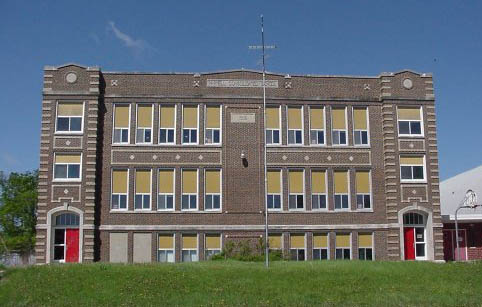| Home | ||
| Records | Research Help | Search | About | |||
| Records :: History: A brief history of Parnell | |
| Home / Records / History / A brief history of Parnell | |

Parnell School, 2002 Source: "Parnell Centennial: 1885-1985 - 100 Years in Little Ireland"
Parnell, in Fillmore Township, Iowa County, Iowa, was named after James Stewart Parnell [this should be Charles Stewart Parnell], a noble Irish statesman who had come to the American people to plead the cause of Ireland's land-impoverished peasants. The Milwaukee Railroad helped to create Parnell. In 1884, the people of the little Irish town of Lytle City moved residences, stores, buildings, and families three miles west to where the railroad was beginning. The people of Lytle City, who were all members of the Catholic Church, then became residents of Parnell. The town was incorporated on March 24, 1891, with a population of 156. The early businesses consisted of a hardware store, grocery store, a drug store, a foundry and blacksmith, a newspaper office, hotel, a livery stable, tavern, dry goods store, millinery shop, a photographer, opera house, and a bank. Catholic church services began in the fall of 1888. St. Joseph's Catholic Church was erected the next year. The Rev. James Davis was its first pastor. This was the largest Catholic Church in the county; and the only church in Parnell until March 16, 1958, when the Parnell Mennonite Church became an organized congregation. The St. Joseph's Cemetery was established in 1892 east of town. The Parnell school district was first known as Locust Grove Independent district. The school house was one mile east of town for the first two years. In order to accommodate the pupils in town and in the western part of the district, school was held in a store building in Parnell in the winter of 1888-1889. Birdie Costello and W.J. Naughton were the first teachers. In 1889, a new one-room building was erected; and later in 1899, a four room brick structure was built. The school became a high school in 1899. In 1907, it adopted the eleventh grade course; and in 1915, it was raised to twelfth grade. In 1916, the Parnell Consolidated School was open-ed, becoming Parnell's first public school. The Sisters of Humility were transferred to this school, until 1955, being one of the few public schools in the state to utilize Roman Catholic nuns as instructors. Early families of Parnell included the Shuells, Murphys, Hannons, Tiernans, Kellys, McDonalds, Dwyers, Callans, Lawlers, Tourneys, McCunes, Mullinex', Naughtons, Quinns, Sheridans, Mastersons, Ryans, Leahys, Murrins, Coakleys, and Carneys. In 1985, businesses included Weldon's DX, Shamrock Cafe, Royal Beauty Salon, Parnell Sandwich & Cone Shoppe, Parnell Tavern, Parnell Post Office, Central Midwest Petroleum, Parnell Cycle Shop, and Johnny O's Car Wash. Early Settlers Probably no settler came into what is now Fillmore Twp. before 1843, when the land was opened up for settlers. William Popham came as early as 1855 from Indiana. Patrick Ryan, born in Ireland, arrived in an early day. Chancy Clothier came from New England in 1849. He moved to Kansas in 1870. Abraham Hall was one of the early settlers. John Phillips came from Illinois about 1855. Nicholas Carey came from Ohio in 1847. Matthew Gray came from Ireland in 1850. Matthew Newcomb came from New York about 1852. D. Callan, Thomas Callan, Edd Carney, and many others were early settlers. The early settlers used oxen for farm work. They sometimes had wagon beds constructed so they could serve as a boat when the river was too high to cross. The first nursery in the township was planted in 1858 by Hermon Berry. Mr. Berry went to Kansas about the year 1860. | |
| Home / Records / History / A brief history of Parnell | |
| Copyright © 2005 IAGenWeb.
All rights reserved. |
|